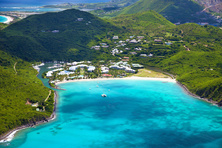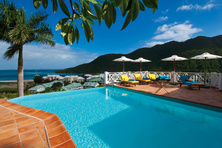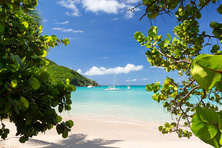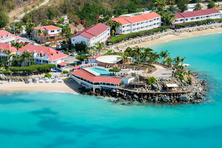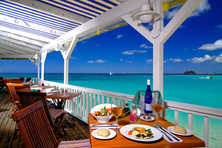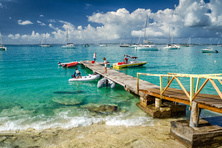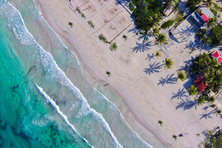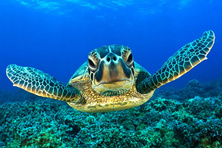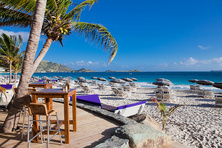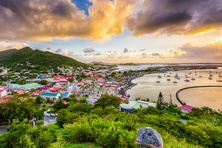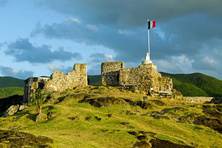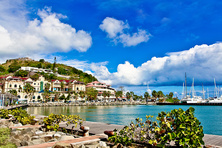Saint Martin
- Capital:Marigot
- Currency: euro
- Time: UTC-4
- Languages: French
- Religions: Christianity (Catholicism)
- Sections: Get in Visa Customs Cuisine Money Details of interest Popular resorts
Saint Martin is an island in the basin of the Caribbean Sea under the sovereignty of two countries. The northern part of the island is administered by France, and the southern one belongs to the Netherlands. In Dutch, the island’s name sounds like Sint Maarten. Marigot is the capital of the French part of the island, and Philipsburg is the capital of the Dutch side.
The weather on the island is warm and dry throughout the year. In July and August, the temperature is at its highest of 32 °C. A rainy season usually begins between September and November. From February to April, the weather remains dry. The best season for spending holidays on Saint Martin is from December to May.
The island’s population is racially mixed. Among the islanders you may meet Creole, half-castes, negroes and even Indians. The vast majority of believers are Catholics.
The official language of the southern side is Dutch, but locals speak Spanish, English and the dialect of Papiamento. In the north, the official language is French, though English and Creole are also used on this side of the island.
Saint Martin attracts tourists especially with its diversity of watersports: windsurfing, diving, kayaking, kitesurfing and boat or yachting tours. Visitors to the island will be also offered other sports: tennis, golf, safari tours and horse riding.
The Dutch side of the island is best known as an extreme beach resort because of the runway at Sint Maarten Airport adjacent to Maho Bay, so tourists virtually sunbathe “under the wings of airplane”.
Sint Maarten attracts sex tourism lovers since the prostitution has been legalized on the island. Most brothels are located in the capital of the Dutch side, Philipsburg. There are also 12 fashionable casinos. Philipsburg is rightly considered a good shopping destination.
A journey to the French side, Saint Martin, would be of interest to the enthusiasts of diving, snorkeling, spearfishing and safari tours. Especially popular are the beaches of Orient Bay, sandy Grand Case and Anse Marcel. Grand Case is home to the island’s best restaurants where tourists will be offered French dishes and the best French wines.
In Marigot visitors to the island will find casinos and other places of entertainment.
Get in
Airplane
The easiest way to reach Saint Martin from Russia and EU countries is to fly. The main airport of the island is Princess Juliana International Airport located on the Dutch side, which serves flights from all over the world. But note that no direct flights are available to tourists from CIS countries.
The other airport is near Grand Case on the French side, which serves flights from neighboring Caribbean islands.
By boat
Visitors to the island can also get there by boat. Cruise ships dock mostly in Philipsburg, the capital of the Dutch side.
Visa
Neither side of Saint Martin is part of the Schengen Area, therefore border-free travel arrangements don’t apply to the island.
If the hotel you’ve booked is located on the Dutch side of the island, you’ll have to apply for a visa at a representation of the Netherlands. In case when your hotel is on the French side, you will apply at an Embassy of France.
Holders of a visa for Saint Martin are not exempt from visa requirements when travelling to France, the Netherlands or any other Schengen country.
Customs
While the border between the French and Dutch territories may not have any official customs points, tourists traveling to Saint Martin from foreign destinations still need to be aware of customs regulations for the island.
Products for personal use (tobacco, alcohol, video cameras, etc.) in small quantities are allowed without being subject to specific customs procedures.
Any form of firearms, illegal drugs, live plants, raw fruits and vegetables are prohibited.
The exportation or importation of endangered species of fauna and flora is illegal.
Visitors to Saint Martin are not allowed to bring in vegetables, plants, animals and any products of animal origin from Haiti.
Cuisine
The original cuisine of Saint Martin is based on Creole, Caribbean and European cooking traditions. Seafood prevails in the islanders’ menu. Lobsters, shrimps, a variety of seashells and seaweeds are the main ingredients of the dishes offered at local restaurants.
When on holidays, we recommend trying snappers cooked on an open fire or wahoos, and Soapy di Piska, fish boiled in coconut milk.
The range of meat dishes offered to tourists looks a bit modest. During the trip, we recommend trying Pasteshis (mincemeat pies), Cabrito Stob (lamb stew) and Ayakashi (meatloaf). Local chefs prepare some original sauces which are reputed to be the feature of the island’s cuisine and distinguish Saint Martin from the other Caribbean islands.
Rice, vegetables and beans are the most popular garnishes to be offered to travelers.
Local pastry chefs will offer original French tarts and cakes as well as Jonny Cake common throughout the Caribbean islands. Those who have a sweet tooth should taste Pudin di Potato (an original potato pudding).
It’s common for the islanders to wash down puddings with a tea or fruit fresh.
The island’s most popular alcoholic beverage is Guavaberry, a native rum-based liqueur.
Saint Martin has its own breweries where some beer brands which are popular in Europe are brewed.
At local stores visitors to Saint Martin will buy some French wines.
Money
The northern French side of Saint Martin uses the Euro as its official currency, while the southern Dutch side uses the Netherlands Antillean guilder which is pegged at 1.8 per USD.
To avoid expensive exchange rates, tourists are advised to exchange their US dollars on the French side of the island.
Euros and US dollars are widely accepted on both sides of Saint Martin; same goes for all major credit cards. However there are some places that don’t accept cards, so tourists should ask beforehand.
Traveler’s cheques in Euros or US dollars are also commonly accepted.
Shopping is duty-free on both sides of the island.
Details of interest
Like most Caribbean destinations, the island of Saint Martin offers a wide range of things to do during your vacation, from relaxing on any of the white sand beaches to lots of attractions. In addition, there are no customs or immigration checkpoints between the French and Dutch sides of the island, meaning that tourists may easily shuttle between both territories.
Places of interest in Saint Martin
On the French side of the island it’s impossible to pass by Fort St. Louis, the most important building in Marigot located on a hill near Marigot Bay;
Marigot Historical and Cultural Museum, an excellent introduction to the culture and history of the island;
Fishermen’s village of Grand Case having a reputation as the gourmet capital;
Pic Paradis, the highest hilltop on Saint Martin at 424 meters;
Loterie Farm located at the foot of Pic Paradis, a former sugar plantation and a real tropical gem;
Butterfly Farm, a must-visit for all nature lovers with hundreds of butterflies in all shapes and colors.
On the Dutch side, Maho Bay is one of the most dangerous beaches in the world due to its abnormal proximity to Princess Juliana International Airport. The air strip located right next to the beach attracts hundreds of spotters every afternoon;
Front Street and Back Street, Philipsburg’s two main streets lined with a whole host of shops offering products at duty-free prices;
Sint Maarten Museum located in the center of Philipsburg invites its visitors to retrace major historical periods;
Fort Amsterdam, the first fort built by Dutch settlers in the Caribbean;
Concordia Mount located right on the border between Saint Martin and Sint Maarten. Atop this mountain the treaty dividing the island of Saint Martin between France and Holland was signed in 1648.
Souvenirs from Saint Martin
Sint Maarten is a completely duty-free destination and attracts shoppers from all over the world. Vacationers will be offered a huge number of duty-free goods in numerous boutiques and shops.
Popular souvenirs that tourists can pick up on the island include local craft and arts, hand-made jewelry, exotic spices and foods, rum-based guavaberry liqueurs and tobacco products.







